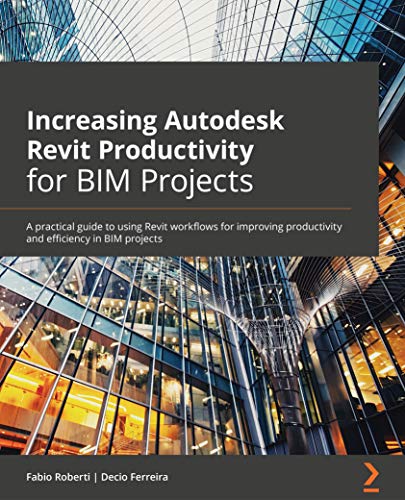Fabio Roberti is the author of Increasing Autodesk Revit Productivity for BIM Projects, we got the chance to sit down with him and find out more about his experience of writing with Packt.
Q: What is/are your specialist tech area(s)?
Fabio: I develop and implement the digital strategy to consolidate processes and workflows to enhance projects deliverables. I also support BIM processes in innovative ways to improve technology adoption with a thorough understanding of British Standards and the ISO 19650 framework. I have many years of experience using Revit and multiple software across all design stages.
Q: How did you become an author for Packt? Tell us about your journey. What was your motivation for writing this book?
Fabio: Packt team contacted me if I was interested in writing a book about Revit, and in the first instance, I wasn’t convinced that writing a book about Revit commands would be the way to express my knowledge. There are many videos available about Revit in the market, and another book about Revit commands will not make sense.
The idea to write a book and become an author was intriguing! My grandfather Mauro is an author, so I might be influenced to write a book as well.
I kept thinking about the book and how I would develop a product that could be interesting to the readers.
In this process, I had an idea to develop a book with experiences to improve productivity and efficiency in Revit.
This type of book is not available in the market, and it would be an exciting project to write a book on how to increase productivity and efficiency in Revit.
Q: What kind of research did you do, and how long did you spend researching before beginning the book?
Fabio: I research if similar books were available in the market and what I would include in the book to succeed and create something that I would enjoy writing.
Q: Did you face any challenges during the writing process? How did you overcome them?
Fabio: Starting writing from a blank screen is the most challenging part, so I sketched some ideas to start, and I would complete these ideas by writing the book.
I have used the Microsoft Word tool “Read Aloud” to listen to my writing and correct the text to become more fluid.
Q: What’s your take on the technologies discussed in the book? Where do you see these technologies heading in the future?
Fabio: Revit enables architects, BIM coordinators, and BIM managers to create BIM models and analyze intelligent data to improve design and construction. Building Information Modeling (BIM) has promoted a transformation in the engineering and construction industries where information is at the core of a methodology that improves productivity, providing several benefits in comparison to the traditional 2D CAD process.
BIM software will become more and more “intelligent” which will provide multiple businesses analysis, and it will support companies in business decisions.
The Information is KING but managing information and knowledge is POWER!
Q: Why should readers choose this book over others already on the market? How would you differentiate your book from its competition?
Fabio: The book is not focused on teaching only the Revit commands, but it has our experience from many years of working in the most challenging projects.
The readers will learn from our experiences how to be more productive in Revit.
The book has a step-by-step explanations of essential concepts and practical examples, this Revit book begins by explaining the principle of productivity in Revit and data management for BIM projects.
The readers will then understand the primary BIM documentation to start a BIM project, including the contract, exchange information requirements (EIR), and the BIM Execution Plan (BEP/BXP).
Later, you’ll learn how to create a Revit template, start a Revit project, and explore the core functionalities of Revit to increase productivity. Once you’ve built the foundation, you’ll learn about Revit plugins and use Dynamo for visual programming and Power BI for analyzing BIM information.
By the end of this book, you’ll have a solid understanding of how to increase productivity in Revit and be able to apply multiple workflows in your project to manage BIM efficiently.
Q. What are the key takeaways you want readers to come away from the book with?
Fabio: There are many key points to learn to improve productivity and efficiency in Revit, but the main takeaway is to plan way your tasks before starting them.
Q. What advice would you give to readers learning tech? Do you have any top tips?
Fabio: Start with a small project and progress to a more complex project. It would help if you kept practicing the software to become fast on it.
It is worth connecting with technology and BIM specialists in social media, such as LinkedIn and Twitter, so you can engage in online talks and learn from specialists.
Q. Do you have a blog that readers can follow?
Fabio: I don’t have a blog, but I usually write on LinkedIn, and this is my profile https://www.linkedin.com/in/froberti/
Q. Can you share any blogs, websites and forums to help readers gain a holistic view of the tech they are learning?
Fabio: These 3 websites are fantastic to keep updated with BIM and technology.
1. AEC Magazine: https://aecmag.com/
It will keep you updated with the latest technology trends, and it provides a free magazine.
2. BIM Plus website: https://www.bimplus.co.uk/
It covers news and technology in the building industry.
3. Autodesk University: https://www.autodesk.com/autodesk-university/
Great content to learn about technology with fantastic classes from specialist across the world.
Q. How would you describe your author journey with Packt? Would you recommend Packt to aspiring authors?
Fabio: I had an excellent experience with Packt, and they support you along the way to write the book.
Yes, I do recommend Packt if you want to become a book author.
Q. Do you belong to any tech community groups?
Fabio: Yes, many tech communities. From my LinkedIn profile, you can see groups that I follow, including Revit, Dynamo, and others.
Q. What are your favorite tech journals? How do you keep yourself up to date on tech?
Fabio: It is the AEC Magazine: https://aecmag.com/, and I engage with the tech community to learn and teach others.
Q. How did you organize, plan, and prioritize your work and write the book?
Fabio: Decio and I had meetings to discuss the book, decide the content and which chapters or sections we would be responsible for writing.
Once we had drafted the ideas, we started to write the book.
Q. What is that one writing tip that you found most crucial and would like to share with aspiring authors?
Fabio: Draft the section or chapter key ideas, research and write. Maybe dividing into small sections each day helps the book continuity.
You can find Fabio’s book on Amazon by following this link: Please click here









